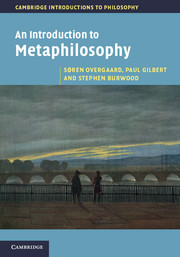4 - The data of philosophical arguments
Published online by Cambridge University Press: 05 March 2013
Summary
Introduction
In the previous two chapters, we have been concerned with the descriptive and prescriptive variants of what we have called the ‘What’ question. But the question of what philosophy is or ought to be is, of course, not independent of the question of how it is (to be) done – whether you think philosophy is part of natural science may be relevant to the sorts of methods you think philosophers ought to employ. In this chapter, our focus shifts to the methodological ‘How’ question. As before, our main focus will be on the prescriptive version of this question. Our question, then, is not how philosophers actually go about justifying their claims, but how they ought to justify them.
There is more than one way to approach the How question. One way is to examine the various patterns of argument characteristically endorsed and employed by philosophers. Although this is doubtless an important task, we shall not attempt it here. Instead of inquiring into the characteristic argument patterns of philosophers, we examine the sorts of considerations that usually function as data in such arguments. A helpful notion in this context is Timothy Williamson’s idea of an academic discipline being disciplined by something. As Williamson explains, ‘To be “disciplined” by X is not simply to pay lip-service to X; it is to make a systematic conscious effort to conform to the deliverances of X.’ What, then, should discipline philosophy? The answer seems to be: all sorts of things! As Williamson writes, philosophy must be disciplined by ‘semantics, … syntax, logic, common sense, imaginary examples, the findings of other disciplines (mathematics, physics, biology, psychology, history …) or the aesthetic evaluation of theories (elegance, simplicity)’.
- Type
- Chapter
- Information
- An Introduction to Metaphilosophy , pp. 70 - 104Publisher: Cambridge University PressPrint publication year: 2013

